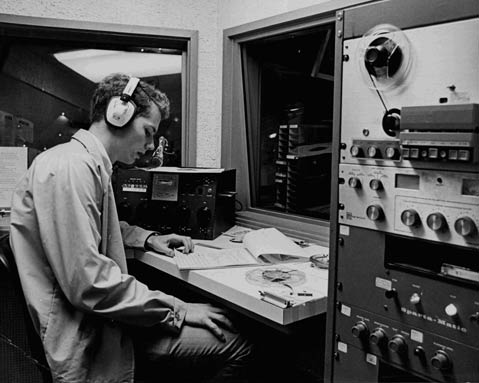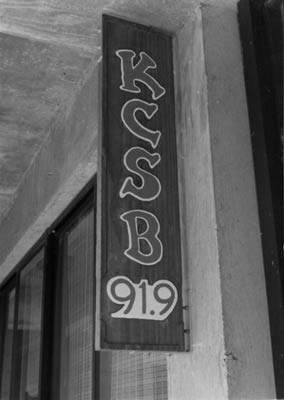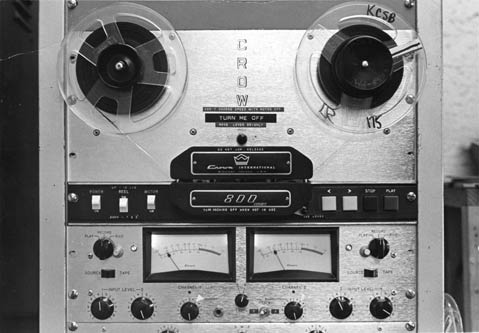A Brief History of KCSB, Part IV
Classed Up, Changed Up and Livened Up

With 1976 came a bit of unpleasant news for KCSB, though you wouldn’t think so at first glance. The FCC sent the station notification that its license, previously a Class D, has been changed to a Class B. Sound like an impressive improvement though this may – what UCSB student languishing in the D end of her or his class hasn’t dreamt, just once, of a B? – it really meant a series of new legal requirements to adhere to. And quickly. Thus ensued the scramble to, among other tasks, officially hire a full-time engineer and set up additional Emergency Broadcast System equipment.
But the crunch to meet the newly imposed standards was surely alleviated by the levity of July 1976’s visit from the National Surrealist Party. Spearheaded by several members of the beloved radio comedy troupe Firesign Theatre, this gag campaign presented its “candidate,” the paper bag-headed George Papoon, and his platform – emblematized by the slogan “He’s not insane!” – to the local press. Naturally, KCSB reporters were present in force to cover it, outnumbering the members of every other Santa Barbara media outlet.

To make the political mix even more interesting, KCSB would later incorporate into its schedule the radio edition of Firing Line, hosted by none other than grand conservative figurehead William F. Buckley. This in addition to Santa Barbara Feedback, a show that opened up the phone lines to let local callers rain questions, comments, and jabs onto political guests such as Assemblymember Gary K. Hart, supervisors Bill Wallace and David Yager, and State Senators Omer Rains and John Briggs. Daily Nexus coverage describes the phone lines as having been “flooded.”
The second piece of unwelcome news arrived in 1977, when KCSB found its signal cut into by the University of Southern California’s radio station, KUSC. Though both stations broadcast on the same frequency, they had peacefully coexisted – until KUSC cranked up its power, encroaching on the southern end of KCSB’s range. With no choice but to change its own frequency, KCSB picked up and moved from 91.5 to the dial position we know and love today, 91.9. That makes it sound a lot easier than it actually seems to have been, but who wants to dwell on the stack of government paperwork and 18 months of processing time – yes, 18 months – it required? Even a precis could take up three installments this brief history of KCSB.

As the 1970s finished up, so did work on the KCSB’s new control room after a nearly four-year renovation process. With fresh turntables, a state-of-the-art cart rack – tape carts now being nothing more than a dim analog memory in the minds of longtime DJs, but never mind – and a much improved mixing console, the station experienced a satisfying measure of real technical improvement. But satisfaction has its price tag, which in this particular case came to $4,000 in 1979 dollars. As for what specific fraction of that year’s whole operating budget the amount represented, the station’s managers probably didn’t even want to compute it. Thus equipped, KCSB marched proudly into the 1980s as one of the vanishingly few college-grown American independent radio stations to survive the ’60s and ’70s without throwing in the towel and succumbing to a generic “rock” format. The new decade would endow the station with a slightly different look, feel, and sound, but the core of eclecticism and community spirit would remain as intact and functional as ever.
This ethos shone through clearly in Livewire, KCSB’s combined program schedule and news magazine – a “‘zine,” to use the parlance of the time – which featured show descriptions, pieces on station happenings, impassioned screeds about various musical subgenres, and interviews with the likes of the Violent Femmes, the Replacements, and Devo. Having been published, though at times sporadically, through the entire 1980s, Livewiredisplayed a visual distillation of the KCSB sensibility: eclectic, ever-changing, composed of countless different viewpoints at once, and always in the process of deviating just a few degrees from its previous path. And, of course, it all pulled off in an exquisitely do-it-yourself aesthetic, whether by cut-and-paste or, later, in classic Apple Macintosh style. But we’re getting ahead of ourselves; the details of KCSB’s life during that stylistically mythologized and now fully nostalgified decade are still to come.



